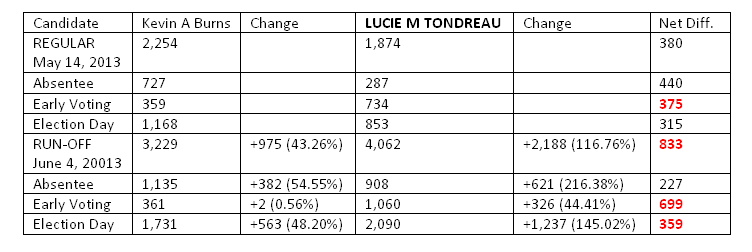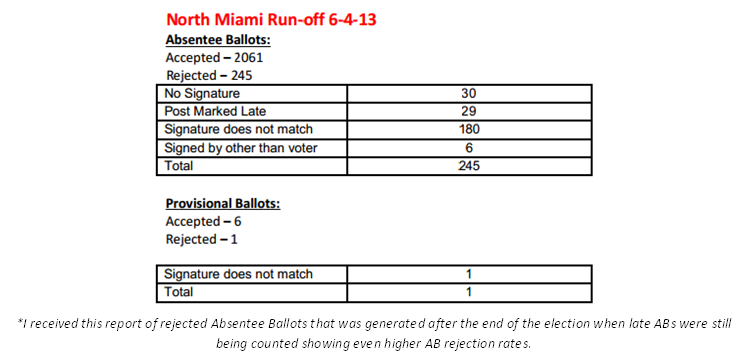 Something funny happened in North Miami
Something funny happened in North Miami
By Hector Roos
Yes, this has to do with mayoral contest in North Miami. No, it is not another post about “Coco Douce” or about the devil hexing candidates for mayor.
This other story has to do with the victory of Lucie Tondreau, the recently sworn in mayor of North Miami, over the former mayor Kevin Burns. The North Miami election was very busy with the mayor and 2 city council seats having to go to a run-off election. Ms. Tondreau was swept into office with 833 votes (about an 11% margin). This margin for victory has never been seen before in North Miami politics.
Maybe Lucie Tondreau is that popular. Maybe North Miami voters really wanted something different than Kevin Burns. Maybe this was just great timing. But something was troubling me about the results and it was mainly this:
Burns had a near 400 vote (over 5%) advantage to Tondreau after the regular election. How did Tondreau manage to pull off a swing of more than 1,200 votes in her favor to defeat a popular, former mayor?
Both the regular and the run-off elections broke records for voter participation with 6,896 and 7,340 ballots cast, respectively. Since the 1999 run-off for mayor with 6,528 ballots cast, no vote totals have even come close compared to these recent elections.
Here are the election results with an eye to the change of total votes cast:
Notice how Burns has an impressive absentee ballot count right from the beginning and how Tondreau made up for it in Run-Off election. I find it very impressive that Tondreau’s campaign was able to get over a 200% improvement of Absentee Ballots cast for her. Similarly, her campaign achieved a massively, successful Get-Out-The-Vote strategy in the little time between the regular and the run-off elections. This was an organizational coup. And I have never seen anything like that anywhere in politics, EVER.
My curiosity was piqued even more by these fabulous results. Was the Tondreau success truly based on the tireless, efforts of her campaign or was it just a simple trick used on a grand scale?
1,981 Absentee Ballots were cast in the regular election with 1,830 counted and 151 disqualified (7.62% of the total). These numbers were from the Voter History Report for the May 14, 2013 North Miami Election made available by the Miami-Dade Elections Department.
2,296 Absentee Ballots were cast in the run-off election with 2,061 counted and 235 disqualified (10.24% of the total). These numbers were from the Absentee Ballot Status Report made available by the Miami-Dade Elections Department.
I have never heard of so many absentee ballots being disqualified before. The absentee ballot rejection rate in the state of Florida was a “high” 1.8% statewide as published by the Tampa Bay Times for last August’s primary elections. The Miami Herald wrote that the November general election had about a 1% rejection rate for absentee ballots in Miami-Dade County.
The fact that over 10 % of absentee ballots cast were rejected in the North Miami Run-Off, far exceeding the county and state rejection rates for absentee ballots, should by itself been publicized by the major news outlets and perhaps referred to authorities for investigation. These results are THAT strange.
By comparing the regular and run-off elections, 482 voters cast Absentee Ballots in the run-off that did not vote in the regular election. These voters did not participate during Early Voting or on Election Day during the regular election either. At least 6.57% of the total ballots cast in the run-off were made by new voters who cast absentee ballots. The report about voters who cast ballots during Early Voting or Election Day is not yet available.
The only error that I can think of that might throw my numbers off a little were votes cast by public officials who are shielded by the county’s privacy law such as police officers and judges.
Remember, the Tondreau campaign won with an about 11% margin. If you are just thinking about these Absentee Ballot numbers you can easily see that something remarkable happened. However, the Tondreau greatest electoral success did not come through Absentee Ballots but during Early Voting and on Election Day where the 3,150 of 4,062 (77.54%) votes for her were cast.
We live in time when Absentee Ballot Fraud and Vote-Buying are commonplace methods to rig elections so these North Miami election results will fuel a lot of speculation and intrigue in the coming weeks. The Miami-Dade Elections Department is holding back the Voter History Report for the 2013 North Miami run-off election that would show who voted in the run-off that chose not to vote in the regular election. When that voter data is made available, there will be a lot more questions asked of this election. In the meanwhile, these election results will remain just a funny thing that happened along with the rest of the craziness of “Coco Douce” and devil hexing.
Hector Roos is a libertarian activist and advocate for open government, fair elections and civic activism. He blogs at Open Government Miami. Roos has never worked in North Miami politics but is an experienced political consultant throughout other parts of Miami-Dade County and is familiar with Florida Election Law and Voter Fraud Issues.








He’s definitely on to something odoriferous in Denmark. An increase in voter participation in a runoff election relative to a general election is virtually unheard of.
However to nail it down a statistical analysis of the results precinct by precinct is necessary, A task that I’m currently engaged in for the NMB run off between Spiegel and Dargenson; it is a rather tedious process. Fortunately I have the software installed to do it.
I’m eagerly awaiting the vote history data to analyze it. I suspect that these “one-time” absentee voters in the runoff have never voted in a local election in the past and had to be individually approached and persuaded, a highly costly, time consuming and difficult task. I personally met several voters like this on my campaign trail and they simply “don’t give a crap” about local politics. They vote for the President only. Only after passionate discussions was I able to persuade a few of them to vote in the local election. My efforts were confirmed as I saw a couple of those people at the polls on election day. However, I presume most of them stayed home on election day or didn’t mail in their absentee ballots. As I said, I will know definitively after I receive the data and report back to you. My bottom line: how the hell did they convince so many people to vote, who did not want to or plan to vote, in such a short time?